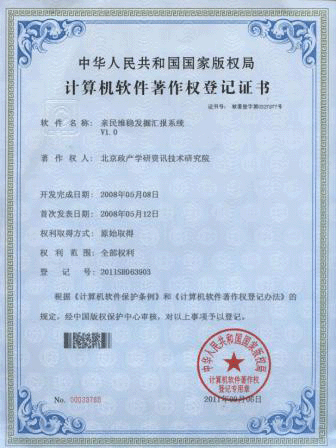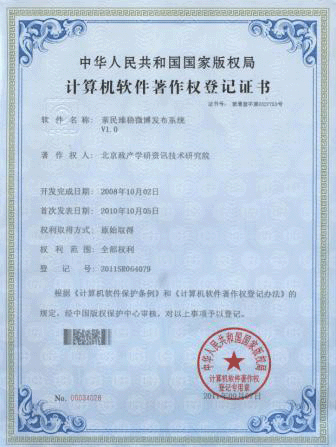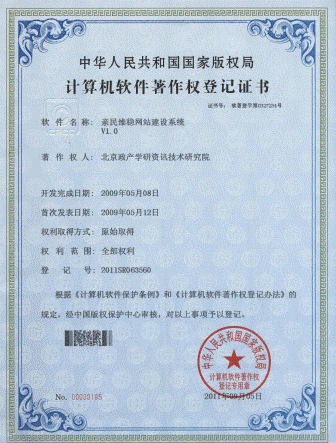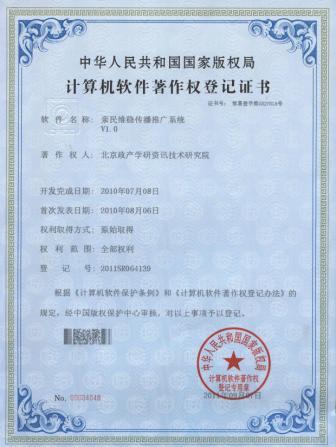亲民维稳热点推荐
- ·被闹钟惊醒后果相当于醉酒? 中医专
- ·中国首例涉外骨髓捐献在徐州采集 韩
- ·农妇产下巴掌大婴儿身长44厘米 体重
- ·卫生部就新版《献血者健康检查要求》
- ·心理专家:“吞钉男”系因渴求关注致
- ·内蒙古将对药品生产流通领域实施电子
- ·新生男婴被扔垃圾桶 目击者称未发现
- ·媒体称农村缺53万医生 不足5%医学生
- ·女子服下网购“秘方胶囊”致癫痫发作
- ·北京长富宫饭店举办首届“淮扬美食文
- ·卫生专家痛斥医院逐利行为 看病贵致
- ·两部门开展秋季中小学学校食堂食品安
- ·河南100新生儿有1个缺陷宝宝 产前诊
- ·7岁男孩在路边打闹遭车祸 睾丸破碎或
- ·卫生部要求做好国庆期间突发事件卫生
- ·调查显示中国居民膳食纤维摄入量不足
即刻使用亲民维稳解决方案!

发掘汇报软件
使用亲民维稳全套解决方案邀请
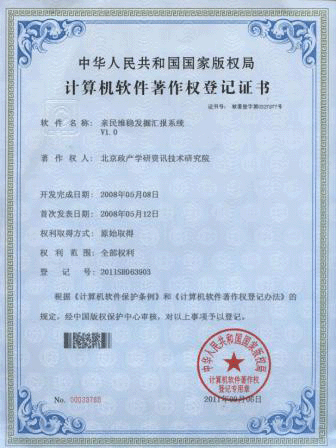
亲稳发掘汇报系统
卫生部介绍近十年来中国医疗卫生事业发展状况--亲民维稳网络舆情监测室
2012-08-18
中新网8月17日电 据卫生部网站消息,在17日举办的2012中国卫生论坛上,卫生部办公厅主任侯岩做了题为《中国医疗卫生事业发展状况》的报告,介绍近十年来中国医疗卫生事业发展状况。报告指,截止2011年底,全国医疗卫生机构达95.4万个。以下是报告全文。
Beijing on August 17, according to the ministry of health news website,In the 17th held on 2012 Chinese health on the BBS,The ministry of health, director of the general office of HouYan do the topic《Chinese medical and health services development situation》report,Introduced in China in the past ten years development of medical and public health services status。The report refers to,By the end of 2011,The medical and health institutions of 954000。The following is the full text report。
中国医疗卫生事业发展状况 Chinese medical and health services development situation
中国政府高度重视医疗卫生事业,坚持卫生工作方针,努力探索中国特色医疗卫生发展道路。进入新世纪以来,中国卫生事业加快发展,覆盖城乡的医疗卫生服务体系基本形成,疾病防治能力不断增强,医疗保障覆盖人口逐步扩大,人民群众健康水平显著提高。
The Chinese government attaches great importance to medical and health services,Adhere to the health work policy,Efforts to explore China's characteristic medical and health development road。Into the new century,Speed up the development of China's health,Covering both urban and rural medical and health service system basic formation,Disease prevention and control increased the capacity,Medical insurance coverage population gradually enlarged,People's health level increased significantly。
一、基本卫生状况 a、Basic health status
一是居民健康状况不断改善。人均期望寿命从2000年的71.4岁提高到2010年的74.8岁。孕产妇死亡率从2002年的51.3/10万下降到2011年的26.1/10万。婴儿死亡率从2002年的29.2‰下降到2011年的12.1‰,5岁以下儿童死亡率从2002年的34.9‰下降到2011年的15.6‰,实现联合国千年发展目标进展顺利。
One is the residents health conditions have constantly improved。Average life expectancy from 71.4 in 2000 to 2010 in raising the age 74.8 years。The maternal mortality rate from 2002 in 51.3/10 descend to 2011 years of 26.1/10。Infant mortality from 2002 in 29.2 ‰ descend to 2011 years of 12.1 ‰,Mortality of children under five years old from 2002 in 34.9 ‰ descend to 2011 years of 15.6 ‰,To realize the UN millennium development goals goes well。
二是卫生资源持续增长。2011年底,全国医疗卫生机构达95.4万个,其中:医院2.2万个、基层医疗卫生机构91.8万个。每千人口医疗卫生机构床位数3.81张、执业(助理)医师1.82人、注册护士数1.66人,每万人口专业公共卫生机构人员4.73人。
The second is health resources sustainable growth。By the end of 2011,The medical and health institutions of 954000,the:Hospital 22000、Basic medical and health institutions 918000。Per thousand population medical and health institutions bedspace 3.81 zhang、practice(assistant)1.82 doctors、Registered nurse number 1.66 people,Per population professional public health agency personnel 4.73 people。
三是医疗卫生服务利用明显增加。全国医疗机构诊疗人次由2002年的21.45亿人次增加到2011年的62.7亿人次;住院人数由2002年的5991万人增加到2011年的1.5亿人。2011年,中国居民平均就诊4.6次,每百居民住院11.3人,病床使用率88.5%,平均住院日为10.3天。2011年,15分钟内可到达医疗机构住户比例为83.3%,其中农村地区达到80.8%。
The third is medical and health services utilization increased significantly。The diagnosis and treatment of medical institutions by the people in 2002 of 2.145 billion rose to 2011 in to 6.27 billion people;The number of hospital increased from 2002 in 59.91 million to 2011 in 150 million。In 2011,,A Chinese resident average 4.6 times,Every residents 11.3 in hospital,Sickbed utilization rate 88.5%,The day in hospital for 10.3 days。In 2011,,15 minutes can be reached 83.3% residents medical institutions,The rural areas reached 80.8%。
四是城乡以及地区间卫生发展差距逐步缩小。2003年,中国城乡居民基本医疗保障覆盖率分别为55%和21%,2011年分别增至89%和97%,发生了重要变化。城乡居民健康指标差距逐步缩小,孕产妇死亡率城乡之比由2005年的1:2.15缩小为2010年的1:1.01;婴儿死亡率城乡差距从7.2个千分点下降到5.9个千分点。农村住院分娩率西部与东部地区的差异由2003年的34个百分点下降到2010年的2个百分点。
The fourth is urban and rural and regional health development gap gradually reduce。In 2003,,China's urban and rural residents basic medical insurance coverage rate were 55% and 21% respectively,2011 to 89% and 97% respectively,Important changes happened。Urban and rural residents health index gap gradually reduce,Maternal mortality ratio of urban and rural areas from 2005 in 1:2.15 narrow for 2010 years of 1:1.01;Infant mortality gap between urban and rural areas from 7.2 permillage points lower down to 5.9 permillage points lower。Rural hospital childbirth differences between western and eastern down from 34% in 2003 to 2% in 2010。
五是卫生总费用发生结构性变化。2002年,中国卫生总费用中个人卫生支出比重高达57.7%,政府预算卫生支出和社会卫生支出分别占15.7%和26.6%。2011年个人卫生支出的比重下降到34.9%,政府预算和社会卫生支出的比重分别提高到30.4%和34.7%。政府卫生支出由2008年的3593.94亿元增加到2011年的7378.95亿元,年均增速为21.68%,明显快于同期卫生总费用和财政支出的年均增速。
Five is total health expenses happen structural changes。In 2002,,China's total health expenses in personal health expenditure proportion reaches as high as 57.7%,The government budget health expenditure and social health expenditure account for 15.7% and 26.6% respectively。In 2011 the proportion of individual health spending dropped to 34.9%,The government budget and the proportion of expenditure on social health increased from 30.4% to and 34.7% respectively。The government health expenditure from 2008 yuan in 359.394 billion increased to 2011 yuan in 737.895 billion,With an average annual rate of 21.68%,Significantly faster than the total health expenses and financial expenses with an annual growth。
二、医药卫生体制改革 two、Medical and health system reform
2009年3月,中国出台《关于深化医药卫生体制改革的意见》及近期重点实施方案,按照保基本、强基层、建机制的基本原则,全面启动深化医改工作,经过三年的努力,初步建立了中国特色基本医疗卫生制度框架。
In march of 2009,Chinese lawmakers《On deepening the reform of medical care system opinion》And the key implementation plan,According to the basic、Strong base、The basic principle of building mechanism,Comprehensive reform deepening start work,After three years of hard work,Preliminary established China's characteristics to basic medical and health system framework。
一是基本医疗保障制度基本建立,实现“病有所医”迈出了关键性步伐。截至2011年,职工医保、城镇居民医保、新农合参保人数超过13亿,覆盖率达到95%以上。新农合从2002年建立,至2011年,参合人数达8.32亿,参合率97.5%,人均筹资标准从2003年的30元提高到2011年的246元,受益人次数从2004年的0.76亿人次提高到2011年的13.15亿人次,政策范围内住院费用报销比例达到70%以上,补偿封顶线达8万元。2010年推行新农合大病保障,截至2011年底,已有近30万包括儿童白血病、儿童先心病、终末期肾病等8种重大疾病患者享受到补偿,实际补偿平均达65%。2012年,又将肺癌、食道癌、胃癌等12种常见多发大病纳入农村重大疾病保障试点范围,费用报销比例最高可达90%。
One is the basic medical security system basic establishment,realize“BingYouSuoYi”Take a critical step。By the end of 2011,Worker health care、Medical insurance for urban residents、New farmers $ginseng protect more than 1.3 billion,Rate is above 95%。New farmers joint from established in 2002,To 2011,Ginseng adds up to more than 832 million,Ginseng adds up to rate 97.5%,Per capita financing standard from 2003 in 30 yuan increased to 2011 yuan in 246,The number of beneficiary from 2004 in 076 million to improve people in 2011 to 1.315 billion people,Within the scope of policy in hospital expense ratio above 70%,Compensation capped line up to 80000 yuan。2010 push new farming combined guarantee a serious illness,By the end of 2011,Nearly 300000 including children leukemia、Children congenital heart disease、End-stage renal disease and eight major disease patients to enjoy compensation,The actual compensation average 65%。In 2012,,And lung cancer、Esophagus cancer、Gastric cancer etc 12 kinds of common multiple serious illness into rural major disease security pilot range,Expense ratio highest can amount to 90%。
二是国家基本药物制度初步建立,基层医疗卫生机构运行新机制逐步形成。截至2011年,基本药物零差率销售覆盖全部政府办基层医疗卫生机构,国家基本药物制度从无到有建立起来,并有序向村卫生室、非政府办基层医疗卫生机构和公立医院延伸。目前,基本药物价格平均下降了30%。同步推进基层医疗卫生机构综合改革,落实财政专项补助和经常性收支差额补助,实施综合量化绩效考核和绩效工资制度,逐步建立新的运行机制。
The second is the national essential medicine system has been set up preliminarily,Basic medical and health institutions operation mechanism is gradually formed。By the end of 2011,Essential drugs zero rate sales covers all the basic medical and health institutions and government,The national essential medicine system built from scratch,And orderly to the village clinic、Non-government basic medical and health institutions and public hospital extension。At present,Basic drug prices fell by 30% on average。Synchronous promote the comprehensive reform of the medical and health institutions,Implement fiscal special subsidies and current balance of income and expenses of subsidies,Implement a comprehensive quantitative performance evaluation and performance salary system,Gradually establish a new operation mechanism。
三是基层医疗卫生服务体系有效夯实,“强基层”的医改目标初步实现。2009年起,中央财政安排资金470多亿元,支持近3.6万个基层医疗卫生机构业务用房建设。启动了以全科医生为重点的基层医疗卫生人才队伍建设,安排3.6万名基层医疗卫生机构在岗人员参加全科医生转岗培训,实施中西部地区农村订单定向医学生免费培养工作,为中西部地区农村基层医疗卫生机构培养1万多人。
Three basic medical and health services system effective compaction,“Strong base”Reform of the target preliminary realization。Since 2009,The central government for capital more than 470 yuan,Support near 36000 grassroots medical and health institutions business occupancy construction。Launched by general practitioners as the focal point of basic medical and health personnel team construction,Arrange 36000 grassroots medical and health institutions on-the-job personnel to participate in general practitioners job-transfer training,Implementation of the Midwest rural order directional medical students free training,For the Midwest rural grassroots medical and health institutions training more than 10000 people。
四是实施公共卫生服务项目,城乡居民公共卫生服务均等化水平明显提高。国家免费向全体居民提供10类41项基本公共卫生服务,经费标准从2009年人均15元提高到2011年的25元,受益人群不断扩大。针对特殊疾病、重点人群和特殊地区,国家实施了农村孕产妇住院分娩补助、15岁以下人群补种乙肝疫苗、农村妇女孕前和孕早期补服叶酸、贫困白内障患者免费复明手术、农村适龄妇女宫颈癌和乳腺癌检查等重大公共卫生服务项目,惠及人群近2亿人。
Four is to carry out the public health services,Urban and rural residents equal access to public health service level obviously improved。National free to all the residents provide 10 class 41 basic public health services,Funds standard from 2009 15 yuan per capita increased to 2011 years of 25 yuan,Benefit from the crowd constantly expand。According to the special disease、Key crowd and special area,National implementation of the rural maternal hospital childbirth subsidy、15 years old the following the crowd resow hepatitis b vaccine、Rural women pregnant and the early stages of pregnancy complement take folic acid、Poor cataract patients free surgery operation、Rural school-age women cervical cancer and breast cancer inspection of major public health services,The crowd to nearly 200 million people。
五是有序推进公立医院改革试点,积累了有益经验。2010年起, 17个国家联系试点城市和37个省级试点地区进行公立医院改革试点,在完善服务体系、创新体制机制、加强内部管理等方面进行积极探索。今年,全国311个县(市)启动县级公立医院综合改革试点,以破除“以药补医”机制为关键环节,统筹推进管理体制、补偿机制、人事分配、价格机制、采购机制、监管机制等方面改革。普遍推行临床路径管理、同级医疗机构检验结果互认、预约诊疗和分时段就诊、双休日和节假日门诊、优质护理服务等措施,控制医疗费用,方便群众就医,提高服务质量。进一步完善鼓励支持社会办医政策,截止到2011年底,全国非公立医疗机构数为45.7万所,占全国医疗机构总数的47.9%,床位数占全国总数的9.7%。
Five is orderly propulsion trial reform of public hospitals,Accumulated a good experience。Since 2010, 17 countries contact pilot cities and 37 provincial pilot region trial reform of public hospitals,In the perfect service system、Innovation system mechanism、To strengthen internal management of active exploration。This year,The country's 311 counties(city)At or above the county level shall start public hospital comprehensive reform pilot,To break“In medicine for medical”Mechanism as the key link,To plan as a whole propulsion management system、Compensation mechanism、Personnel distribution、Price mechanism、Procurement mechanism、Reform of the supervision mechanism, etc。Universal implementation of the clinical pathway management、The medical institutions inspection result recognition、Make an appointment diagnosis and treatment and a period of time、Weekends and holidays outpatient service、High quality nursing service measures,Control medical cost,Convenient masses go to a doctor,Improve the service quality。To further improve medical policy to encourage and support social do,By the end of 2011,The non public medical institution number is 457000,Accounted for 47.9% of the total number of medical institutions,Bedspace accounted for 9.7% of the total。
亲稳链接:链接亲民维稳,践行稳中求进!
- “倒药买房”入狱病根在哪里--亲稳舆论引导监测室
- 深圳卫人委:深圳暂未发现人感染H7N9禽流感病例--亲稳舆论引导监测室
- 北京医疗队赴地震灾区 两天完成十余台手术--亲稳舆论引导监测室
- 风疹与风吹无关 多开窗通风少去公共场所--亲稳网络舆情监测室
- 气候无常 小心过敏性鼻炎--亲稳网络舆情监测室
- 留学生在家“药流”引起宫外孕--亲稳网络舆情监控室
- 男子被实施手术后性功能丧失 法院判医院赔74万--亲稳网络舆情监测室
- 血压高早起5项注意:起宜缓 水宜温 动宜适--亲稳舆论引导监测室
- 农业部:上海禽流感防控做法值得推广--亲稳舆论引导监测室
- 用储奶袋保存母乳安全吗?关键在于储存方法--亲稳舆论引导监测室
- 男子白癜风扩散新娘“落跑” 还丢了工作--亲稳舆论引导监测室
- 国家药物政策与医药产业经济研究中心南京成立--亲稳舆论引导监测室
- 食药监局:前三月查处违法食品药品广告4万多条次--亲稳舆论引导监测室
- 贵阳市民五一连喝三天酒 酒精中毒产生幻觉--亲民维稳网络舆情监测室











